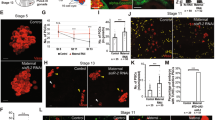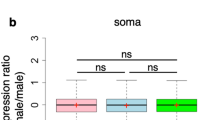Abstract
Metazoans use diverse and rapidly evolving mechanisms to determine sex. In Drosophila melanogaster an X-chromosome-counting mechanism determines the sex of an individual by regulating the master switch gene, Sex-lethal (Sxl)1. The X-chromosome dose is communicated to Sxl by a set of X-linked signal elements (XSEs), which activate transcription of Sxl through its ‘establishment’ promoter, SxlPe. Here we describe a new XSE called sisterlessC (sisC) whose mode of action differs from that of previously characterized XSEs, all of which encode transcription factors that activate Sxl Pe directly. In contrast, sisC encodes a secreted ligand for the Drosophila Janus kinase (JAK) and ‘signal transducer and activator of transcription’ (STAT) signal transduction pathway and is allelic to outstretched (os, also called unpaired). We conclude that sisC works indirectly on Sxl through this signalling pathway because mutations in sisC or in the genes encoding Drosophila JAK or STAT reduce expression of SxlPe similarly. The involvement of os in sex determination confirms that secreted ligands can function in cell-autonomous processes. Unlike sex signals for other organisms, sisC has acquired its sex-specific function while maintaining non-sex-specific roles in development, a characteristic that it shares with all other Drosophila XSEs2.
This is a preview of subscription content, access via your institution
Access options
Subscribe to this journal
Receive 51 print issues and online access
$199.00 per year
only $3.90 per issue
Buy this article
- Purchase on Springer Link
- Instant access to full article PDF
Prices may be subject to local taxes which are calculated during checkout



Similar content being viewed by others
References
Cline, T. W. & Meyer, B. J. Vive la différence: males vs females in flies vs worms. Annu. Rev. Genet. 30, 637–702 (1996).
Walker, J. J., Lee, K. K., Desai, R. N. & Erickson, J. W. The Drosophila melanogaster sex determination gene sisA is required in yolk nuclei for midgut formation. Genetics 155, 191– 202 (2000).
Timmer, J. R. A screen for new mutations in numerator elements of the X:A signal in Drosophila. Thesis, Univ. California, Berkeley ( 1995).
Sanchez, L., Granadino, B. & Torres, M. Sex determination in Drosophila melanogaster: X-linked genes involved in the initial step of Sex-lethal activation. Dev. Genet. 15, 251–264 (1994).
Anand, A. & Chandra, H. S. Synergistic interaction between particular X-chromosome deletions and Sex-lethal causes female lethality in Drosophila melanogaster. J. Genet. 73, 81–90 (1994).
Ferrus, A., Llamazarares, S., de la Pompa, J. L., Tanouye, M. A. & Pongs, O. Genetic analysis of the Shaker gene complex of Drosophila melanogaster. Genetics 125, 383–398 (1990).
Harrison, D. A., McCoon, P. E., Binari, R., Gilman, M. & Perrimon, N. Drosophila unpaired encodes a secreted protein that activates the JAK signaling pathway. Genes Dev. 12, 3252–3263 (1998).
Erickson, J. W. & Cline, T. W. Key aspects of the primary sex determination mechanism are conserved across the genus Drosophila. Development 125, 3259– 3268 (1998).
Keyes, L. N., Cline, T. W. & Schedl, P. The primary sex determination signal of Drosophila acts at the level of transcription. Cell 68, 933–943 (1992).
Estes, P. A., Keyes, L. N. & Schedl, P. Multiple response elements in the Sex-lethal early promoter ensure its female-specific expression pattern. Mol. Cell. Biol. 15, 904–917 (1995).
Binari, R. & Perrimon, N. Stripe-specific regulation of pair-rule genes by hopscotch, a putative Jak family tyrosine kinase in Drosophila . Genes Dev. 8, 300– 312 (1994).
Hou, X. S., Melnick, M. B. & Perrimon, N. marelle acts downstream of the Drosophila HOP/JAK kinase and encodes a protein similar to the mammalian STATs. Cell 84, 411–419 (1996 ; (erratum ibid 85, 290a ( 1996).
Yan, R., Small, S., Desplan, C., Dearolf, C. R. & Darnell, J. E. Jr Identification of a Stat gene that functions in Drosophila development. Cell 84, 421–430 (1996).
John, S., Vinkemeier, U., Soldaini, E., Darnell, J. E. Jr & Leonard, W. J. The significance of tetramerization in promoter recruitment by Stat5. Mol. Cell. Biol. 19, 1910–1918 (1999).
Carmi, I., Kopczynski, J. B. & Meyer, B. J. The nuclear hormone receptor SEX-1 is an X-chromosome signal that determines nematode sex. Nature 396, 168–173 (1998).
Chou, T. & Perrimon, N. The autosomal FLP-DFS technique for generating germline mosaics in Drosophila melanogaster. Genetics 144, 1673–1679 (1996).
Kuo, Y. M. et al. Salivary duct determination in Drosophila: roles of the EGF receptor signalling pathway and the transcription factors fork head and trachealess. Development 122, 1909–1917 (1996).
Acknowledgements
P. Sziber helped isolate sisC mutations, L. Wrischnik helped generate sisC+ transgenes, N. Perrimon and colleagues provided material before publication, and B. Meyer helped with writing. Supported by an NIH Grant to T.C. and by Wellcome Trust and Human Frontier Science Program fellowships to L.S. and F.B.
Author information
Authors and Affiliations
Corresponding author
Rights and permissions
About this article
Cite this article
Sefton, L., Timmer, J., Zhang, Y. et al. An extracellular activator of the Drosophila JAK/STAT pathway is a sex-determination signal element. Nature 405, 970–973 (2000). https://doi.org/10.1038/35016119
Received:
Accepted:
Issue Date:
DOI: https://doi.org/10.1038/35016119
This article is cited by
-
The autoregulatory loop: A common mechanism of regulation of key sex determining genes in insects
Journal of Biosciences (2016)
-
Somatic control of germline sexual development is mediated by the JAK/STAT pathway
Nature (2005)
-
Identification of JAK/STAT signalling components by genome-wide RNA interference
Nature (2005)
-
Sex determining signal inDrosophila melanogaster
Journal of Genetics (2004)
-
Functional conservation of the Sex-lethal sex determining promoter, Sxl-Pe, in Drosophila virilis
Development Genes and Evolution (2003)
Comments
By submitting a comment you agree to abide by our Terms and Community Guidelines. If you find something abusive or that does not comply with our terms or guidelines please flag it as inappropriate.



